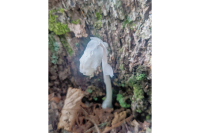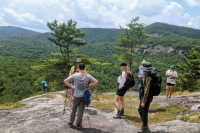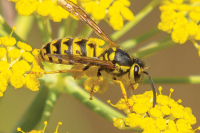The Naturalist's Corner: Goose dilemma
A spin around Lake Junaluska the other day (12/2) turned up another unusual winter visitor plus highlighted the foibles and frustrations sometimes associated with birding.
I had finished a quick check of the new wetlands and was headed back to my truck when I noticed a stranger among the resident gaggle of domestic greylag geese. The stranger was white with black wingtips, so snow goose immediately came to mind. The size difference between the visitor and greylags was pronounced — making me think this visitor was a very small goose — therefore a Ross’s.
The Ross’s, Chen rossii, is a small (23 inches) goose that looks for the most part like a miniature version of the snow goose. It comes in two color phases, like the snow goose — one, white with black wingtips and the other, a dark or “blue” phase. The main difference between the two species other than size is head and bill shape and/or features.
The Ross’s has a rounded head and short bill. The base of the bill — where it meets the bird’s face — is straight. And the Ross’s has little or no “grin patch.” The grin patch is the black serrated edge of the bill, prominent in snow geese that make the bird look like it’s grinning. This grin patch or serrated edge is highly developed in snow geese and enables them to saw off tough marsh grasses and sedges.
The snow goose (both subspecies lesser, Anser caerulescens caerulescens and greater, Anser caerulescens atlantica), besides having a prominent grin patch, has a longer bill with a more wedge-shaped head. And the area where the beak meets the face is curved outward, away from the eye. It’s not a straight edge like in the Ross’s.
Birding foibles 101
I looked no further than the obvious white-morph snow goose form and size discrepancy between the visitor and its greylag hosts. Not wanting to spook the bird, I returned to my truck and called a friend to say I had just found a Ross’s goose at the lake. My friend was running errands and we made a date to meet back at the lake.
When I got to the lake, my friend was there with his scope watching the goose and concurred that it was a Ross’s. The gaggle had taken to the water and once again it was easy to see the major size discrepancy. We chatted about what else was around the lake and watched as the birds swam a little closer. When I looked through my binoculars at the little fella, I noticed a grin patch. I mentioned it, but didn’t think much about it and I hit the road.
But that grin patch kept bugging me. I came home, looked online at some photos and looked on page 79 of my copy of The Sibley Guide to Birds, where he illustrates the head pattern of a Ross’s, a Ross’s X lesser snow, a lesser snow and a greater snow. I realized I had shot from the hip and needed to get a better look at that bird.
Friday morning I headed for the lake. I called my friend to say I had questions. Turned out, I wasn’t the only one.
A couple of other experienced birders had a similar experience; one, immediately identifying the visitor as a Ross’s because of the comparative size difference; then, with longer looks, especially focusing on the head, questioning that ID.
So Friday morning, the four of us with binoculars a field guide and photos were standing there within 100 feet of the bird. The one consensus was that the head was definitely snow goose. I and one other birder (I think) are mostly convinced that the bird is a lesser snow. One, I believe, was as of Friday, leaning towards greater snow and the other was still having trouble committing.
What threw us all initially was the size discrepancy. But what we failed to take into account is the fact that greylags are giants of the goose world and those domestics are probably large greylags.
As large as greylags are, I don’t think they would dwarf a greater snow goose (listed at 31 inches in my Sibley guide) the way they dwarf this bird. But I would think a Ross’s X lesser snow’s head would have intermediate characteristics like Sibley depicts — this goose’s head looked all snow to me — so I’m left with a small (probably female) lesser snow goose.
Now birders of varying skill levels can get a seconds-long glimpse of a black and white bird in a swamp and never see it again and be 100 percent sure they’ve seen an ivory-billed woodpecker. While four “fairly” experienced birders with a cooperative subject and time to study are still left with “in my opinion.”
Ain’t birding a hoot?
Don Hendershot can be reached at This email address is being protected from spambots. You need JavaScript enabled to view it.
Plans moving forward for Caring for Creation conference
Early registration is currently under way for the 2011 Caring for Creation experience at Lake Junaluska Conference and Retreat Center on March 31-April 3, 2011.
Caring for Creation is a loosely organized movement of faith communities that believe there is Biblical and theological support for developing opportunities to be caretakers of the Earth.
The Rev. Sally Bingham, a priest in the Diocese of California who serves as the Environmental Minister at Grace Cathedral in San Francisco, will be a guest speaker at the 2011 Caring for Creation. She is a founder of the Regeneration Project, a non-profit ministry focusing on the response to global climate change, whose initiative is the Episcopal Power and Light.
The model has developed into an interfaith initiative in several states and in Canada, and its mission is to mobilize the community of faith to lead by example in reducing green house gas emissions.
“The Rev. Bingham is giving a plenary, ‘A Religious Response to the Climate Crisis,’ and her workshop will focus on the work of Interfaith Power and Light,” said Loy Lilley, event coordinator for Caring for Creation. “We are excited about this ever growing opportunity to learn diverse ways to preserve and care for our Earth, and we hope that persons from all walks of life and of all ages will come.”
More than 38 guest speakers, including John Hill, Director of Economic and Environmental Justice from the General Board of Church and Society of The United Methodist Church, will appear at the Caring for Creation conference. Other guest speakers include Derek Arndt of the National Climate Data Center; Dr. Brian Helmuth, professor of Biological Science at USC in Columbia, S.C.; and Dr. Jim McKenna, interim department head and professor of crop and soil environment sciences at VPI in Blacksburg, Va.
New workshops will be available this year, including “How Harming Earth Harms Heart, Mind, and Soul” by Andy Bell. Other workshops include “Biblical/Theological Foundations of Creation and Wesley” by Rev. Jeanne Finley;“Involving Young People in God’s Call to Hope and Action” by Mr. John Hodges-Batzka; and “How to advocate for Environmental Sustainability” by Mr. John Hill.
The first 50 persons to register will receive a free copy of Jonathan Merritt’s book, Green Like God: Unlocking the Divine Plan for Our Planet. Merritt is also a speaker and workshop leader. Special early registration will be available for persons registering before Jan. 1. Ethnic scholarships will be available online soon. For registration, workshops, and more information visit www.lakejunaluska.com/caring-for-creation or call 828.454.6656.
Junaluska Assembly selects new director
John “Jack” L. Ewing, Jr. has been named the new executive director of Lake Junaluska Assembly. He will begin his new duties on Jan. 1, 2011, and fills a position that is being vacated by the retirement of Rev. Jimmy L. Carr.
Ewing currently serves as the executive director of the Foundation for Evangelism, which is also based at Lake Junaluska.
“I am excited about the opportunity to build on the good work of those that have gone before me. This is a special place and together we will make it an even more special place for many more people,” said Ewing during a presentation to the Lake Junaluska Board of Directors.
Dr. Ewing has degrees from Asbury College (1974), the University of Kentucky (1975), and the University of Minnesota (1982). He has served on the faculty of his alma mater and South Dakota State University, and as president of two United Methodist institutions of higher education: Dakota Wesleyan University (1994- 2000) and Mount Union College (2000-2005).
In 2010, Lake Junaluska will host 150,000 people from all 50 states and over 40 countries. Lake Junaluska is owned by The United Methodist Church and is open to all for vacations, banquets, reunions, weddings, spiritual enrichment retreats, conferences and recreational activities.
Digging out Lake Junaluska … again
In the ongoing battle to keep Lake Junaluska from filling with silt, the lake will once again be partially lowered this winter so accumulated sediment can be dug out.
Scooping sediment out of the lake is a costly proposition. There have been four digs over the past decade, costing $1.7 million. Of that, $1.2 million came from state and federal grants, and Lake Junaluska Assembly contributed $500,000.
When the first “big dig” was undertaken at the beginning of the decade, so much sediment had accumulated it was a mere four to eight inches from the lake’s surface around the mouth of Richland Creek.
“At that point we were in danger of losing that whole west end of the lake,” said Jimmy Carr, executive director of Lake Junaluska.
Carr and his team first had to play catch-up before putting in place a plan to keep sediment at bay with smaller digs every other year.
“The problem will never be solved. What we are trying to do is get it so it is manageable,” said Buddy Young, director of residential services with Lake Junaluska Assembly.
To set the stage for periodic clean-outs, the lake bottom was reshaped near the mouth of Richland Creek to confine sediment being dumped into the lake into one area, making it easier for the bulldozer operators to get at.
This next round of sediment dredging will cost $300,000 — with half coming from the state and half from Lake Junaluska Assembly.
Lake Junaluska requested $350,000 for the dredging back in 2009, but it didn’t come through that year. Carr said the assembly is thankful Sen. Joe Sam Queen, D-Waynesville, continued to fight for the appropriation.
“He really stayed with it in a very difficult budgeting time,” Carr said.
The economic impact of Lake Junaluska Assembly on the entire region helped win the funding.
“Lake Junaluska is a valuable asset to the Haywood Community and the entire region,” said Queen.
Lake Junaluska Conference and Retreat Center attracts 100,000 people each year for dozens of conventions held on its grounds, with an annual economic impact in the millions plus intangible benefit of outside exposure.
The sediment piling up in Lake Junaluska is a countywide problem. One only has to look at the color of Richland Creek during a heavy rain to see the mud and erosion making its way into the water.
“When it hits the lake it slows and the silt settles out,” Carr said.
The lake can be unsightly while work is being done. Lower water levels expose a ring of mud around the shore in the main part of the lake, and a mudflat in shallower areas. The work usually raises eyebrows.
“I think a lot of the locals understand this is a regular thing, but for visitors to the area it is the No. 1 question we get during the draw down: is there something wrong with the lake and why are you doing this?” said Ken Howle, marketing director for Lake Junaluska Assembly.
Though there has been some discussion of sacrificing the lake at the mouth of Richland Creek and allowing it to become a wetland, Young said it would not be a good route to take.
“It is not like it would build up a good quality wetland. It would be a shifting sand bar,” Young said.
A couple of wetlands have been created in the shallow part of the lake, however, benefiting wildlife.
40th Smoky Mountain Folk Festival showcases authentic mountain music and dancing
Mountain music, dancing and tradition will be on display on the shores of beautiful Lake Junaluska as the Smoky Mountain Folk Festival, now in its 40th year, celebrates the culture and heritage of Western North Carolina.
As in years past, spectators will be treated to performances by more than 200 mountain dancers and musicians at the 2,000-seat historic Stuart Auditorium on the grounds of Lake Junaluska. Each night will feature open tent shows on the lawn beginning at 5 p.m. with main stage performances at 6:30 p.m. The entertainment will continue well into the night with the last performances ending some time after 11 p.m.
The festival is one of the longest running and most authentic folk festivals in the South, and offers spectators the chance to experience a wide variety of the region’s best traditional performers. Scores of the region’s finest fiddlers, banjo players, string bands, ballad singers, buck dancers and square dancers will be in attendance. Visitors will also be treated to the unique regional sounds of the dulcimer, harmonica, Native American flute, bagpipes and spoons, even a bowed carpenter’s saw.
While the festival is sure to entertain the thousands of people who attend, it also serves as a venue to preserve the mountains’ legacy of traditional music and inspire a new generation of artists as they swap tunes and licks, song and stories, under the open tents on the lakeshore.
“Our Appalachian identity with its music, stories, song and dance is something we can be proud of and must share with others to keep it alive. It is an identity that enriches all who experience it,” said festival director Joe Sam Queen.
The Smoky Mountain Folk Festival had its beginnings as a collaboration between Queen and a master fiddler named Earnest Hodges. Queen’s grandfather had passed away shortly before and Queen and his family sought to celebrate the music and dancing his grandfather had loved so much.
“My grandfather Sam Queen made mountain music and dancing such a big part of this community’s life, we wanted to carry on this family tradition and share it with the community just as he had done,” said Queen.
Queen and Hodges put together those early festivals in the high school gymnasium of what is now Waynesville Middle School. They worked together to contact and lineup an extensive collection of mountain artists to perform. The festival was a success for the community, attracting hundreds of visitors and locals each night.
Now a tradition with decades of history, the festival has established itself as a family and community gathering with many performers returning each year to see old friends and make new ones. Families return each year with new generations to enjoy what is one of the richest cultural events of the year.
Main show tickets are $12 at the door, $10 in advance, with children under 12 admitted free. Advance tickets can be purchased at the Haywood County Arts Council at 86 North Main Street in Waynesville or at the Administration Building at Lake Junaluska.
And of course, in keeping with tradition, there is always a complimentary slice of cool watermelon available to all who attend.
Children and youth provide leadership at Peace Celebration
Lake Junaluska Assembly invites youth and children to become peacemakers at the 2010 Lake Junaluska Peace Celebration: Mosaic of Hope, Sept. 18 through 19. The unique two-day event features leadership from children’s activist Jeni Stepanek, as well as youth and children facilitators.
Stepanek is a noted advocate for children’s and families’ needs in health and education, and a well-respected motivational speaker.
Youth Celebration participants will engage in hands-on learning experiences with various organizations, including Paper Clips: The Holocaust Project, Invisible Children and Creative Expressions for Peace. Younger children will participate in artistic responses and learn techniques to verbalize their feelings instead of acting on them, especially with regard to coping with stress, anger, and bullying.
Adults, youth and children are also encouraged to participate in the Peace Walk and Festival of Peace, which bridges the Peace Celebration with the annual Lake Junaluska Peace Conference that runs Sept. 19 through 21.
www.lakejunaluska.com/peace-celebration or call 828.454.6656.
Atmosphere wins over delegates to Lake J’s Methodist conference
Lake Junaluska, a century-old retreat for Methodist clergy and their families, will remain the favored venue for a major annual conference of the United Methodist Church.
The Western North Carolina Conference — a formal gathering of Methodist churches from the western half of the state — brings thousands of people to Lake Junaluska and Haywood County for an extended weekend every June. But space limitations had prompted the conference to consider a change in location to a Sheraton Hotel conference center in Greensboro.
Losing the conference would be a major economic blow not only to the Lake but to hotels and restaurants throughout Waynesville and Maggie Valley. Between half and two-thirds of conference attendees who stay overnight find lodging off Lake grounds.
Whether to change venues was put to a vote during the annual conference this past weekend. Lake Junaluska won out overwhelming with 1,007 votes, compared to 526 for moving it.
“Logistically, it would be better for us to have a bigger building, but as a far as the overall atmosphere of the conference, they prefer here,” said Roy Miller, a delegate from Mount Airy, N.C., and pastor of Mt. Moriah Methodist Church.
Jimmy Carr, executive director of Lake Junaluska Assembly, had no idea what to expect before the vote.
“The margin was so high. That was really affirming to us,” Carr said.
The conference was attended by 2,660 delegates representing Methodist churches across half the state — a territory reaching as far as Greensboro and Charlotte — to discuss church policies and finances and ordain clergy. Delegates often have their families and church lay people in tow, with the total number of people in town for the conference pegged at about 7,000.
Debbi Snipes has accompanied her husband, a minister from Charlotte, to the annual conference at the Lake for 17 years, along with her two daughters. It would be a “big mistake” to move the venue, she said.
“This is a family friendly place. This is a special place, and you can’t get that just anywhere,” said Snipes, who enjoys seeing the same families year after year. If the conference was moved to a Sheraton Hotel in Greensboro, “we wouldn’t go,” Snipes said.
The annual conference is only one small slice of the Lake’s conference business, which plays host to 100,000 people each year for dozens of conventions of both a spiritual and secular nature.
But this conference is by far its largest. The potential loss lit a fire under those in the tourism industry. Some nearby restaurants changed the lettering on their signboards to boast messages of support for keeping the conference at the Lake.
The annual conference brings in $200,000 of direct revenue to the Lake Junaluska Assembly and another $300,000 for local motels, restaurants and the like. The multiplier effect across WNC communities could be up to $1 million, Carr estimated.
The conference venue was the most hotly discussed topic of the weekend, said Miller.
“They mention waking up in the morning and seeing the cross, the mountains and the lake,” Miller said.
The majority felt the impersonal setting of a Sheraton Hotel would not nurture the fellowship found at the Lake, he said. Small prayer groups and impromptu religious discussions come naturally in intimate and inspirational settings found on Junaluska’s grounds, from the numerous gardens to lakeside benches. It would not be easy to duplicate that atmosphere in a hotel lobby.
“It is hard to imagine leaving the Lake because of the setting and significance of this place,” said Eddie Ingram, pastor at First Methodist Church in Charlotte.
Carr said the discussion leading up to the vote was heartfelt and emotional. One woman spoke about the personal transformation she feels when attending the conference at the Lake.
“They realized the specialness of Lake Junaulska,” Carr said. “They realized they are about doing church work and what better place to do it than Lake Junaluska, which has a common mission.”
The Lake made a couple of promises to keep the conference. A logistical challenge is posed by Stuart Auditorium, which seats 2,000 people and can’t accommodate all the delegates who attend. Other meeting halls and auditoriums on the Lake’s grounds will be rigged with live video streaming to allow people who can’t fit inside Stuart Auditorium to still participate in the proceedings.
The other promise is to work with the local tourism community to roll out the red carpet for conference attendees.
Of the 2,600 delegates who attended, only 800 rented hotel rooms or homes at the Lake itself, leaving a huge number to find lodging elsewhere. The conference wants the Lake to compile lodging information and negotiate discounts with local hotels during the conference weekend. In addition, the conference wants assurance that the local hotels and restaurants off the Lake grounds are prepped and ready to step up their hospitality the weekend of the conference.
“It is truly going to take the entire county working together to keep this event here in the long term. Lake Junaluska will need a strong partnership with the local community to accomplish that,” said Ken Howle, Lake Junaluska marketing director.
Lake Junaluska at risk of losing most meaningful conference
Despite its peaceful atmosphere and long history as a spiritual center for Methodists, Lake Junaluska may lose the annual United Methodist Church conference it has hosted for more than half a century.
Space limitations at the Lake have prompted the Western North Carolina Conference of the United Methodist Church to study alternative locations for its annual conference. A task force recently recommended moving the event to Greensboro on a trial basis in 2011.
“To lose a major conference is very difficult,” said Jimmy Carr, executive director of the Lake Junaluska Conference & Retreat Center. “We feel a kinship with the WNC annual conference.”
The annual conference brings about 2,600 delegates who flock to Western North Carolina for the week-long conference every June — along with their families. In the process, they support the hotels, restaurants, and shops that have come to count on their business.
It is only one small slice of the 100,000 people who come to the Lake for conferences and conventions each year, but the potential loss is being lamented by tourism leaders.
“That would be a huge blow,” said Alice Aumen, chairperson of the Haywood County Tourism Development Authority. “Everybody looks forward to conference week.” According to Lake Junaluska’s estimates, the conference brings approximately $200,000 to the Lake Junaluska Assembly each year, mostly from lodging and meals.
In addition, the conference generates $300,000 of direct revenue to local motels, restaurants and other businesses. The multiplier effect across WNC communities could be up to $1 million, Carr said.
Clergy and lay members will vote on the proposal at this year’s annual conference on Saturday, June 12. During the annual conference, delegates from United Methodist churches from the Tennessee state line to east of Greensboro converge on the Lake to discuss church policies and ordain clergy.
A report released by the WNC Conference task force stated that Lake Junaluska’s Stuart Auditorium could accommodate only 2,000 of its total 3,500 delegates, though not all members attend each year. Parking, lodging and “meal options” are also severely limited, the report reads.
“I don’t think that anyone would say anything against Junaluska,” said Mark Barden, communications director for the WNC Conference. “It’s a wonderful place. It has a place in our hearts and our history. It’s just that it can’t accommodate what we need right now.”
The task force recommends moving the conference to Joseph S. Koury Convention Center, located at The Sheraton Greensboro Hotel, which would offer 988 hotel rooms, plentiful free parking and multiple meal options at a nearby mall.
Carr pointed out that while the location may accommodate more delegates, it is a secular venue, whereas Lake Junaluska has been a gathering place for Methodists for 100 years.
“That doesn’t mean that they can’t provide the services,” said Carr. “But they won’t be able to provide them the kind of surroundings, the settings, the natural places for worship and reflection that Lake Junaluska can provide.”
Many clergy members trace back their ordainment to Lake Junaluska, while delegates have grown accustomed to convening there year after year on what many call holy ground.
“There’s definitely a long history and a lot of sentimental attachment,” agreed Barden.
Decades ago, Stuart Auditorium had hosted Haywood County high school graduations, but space limitations at the facility forced that event off grounds as well.
Carr said Lake Junaluska leaders are presently considering expanding Stuart Auditorium or building a similar venue that will accommodate more people.
“It’s a 100-year-old building that’s been changed through the years, and it’s no doubt that Lake Junaluska needs a [larger,] different kind of space,” said Carr.
Space limitations actually brought the WNC Conference to the lake in the first place. Church leaders voted to move the event to Lake Junaluska after membership grew too large for the local church where the conference had been held before.
“They faced the same problems that we face now,” said Barden.
The WNC Conference has earlier voted on moving its annual conference away from the Lake, but that measure was defeated.
On Monday, Town of Maggie Valley clerk Vickie Best sent out a memo to local leaders and business owners, campaigning for another such defeat.
“Now is the time to talk to the attendees staying at your motel, shopping at your store, or eating at your restaurant,” the email read. “Encourage those folks to vote to stay at Lake Junaluska, where they can enjoy the beauty of the Lake, and the comfort of our valley and mountains.”
Meanwhile, the potential loss of revenue would prove bad timing for the Lake Junaluska Conference and Retreat Center.
Starting this year, Lake Junaluska will see around $1 million of its operating revenue disappear over the next four years. Instead of subsidizing operations and ministry programming, that money will be reallocated to debt reduction and capital improvements.
The Methodist conference and retreat center has received a long-standing annual subsidy from the Southeastern Jurisdiction of the United Methodist Church, paid by churches from across the nine-state region.
But the subsidy for operations and programming will be reduced over the next four years, which has already forced the Lake to work harder to recruit more conferences to the site to make up the difference.
Peace for the World’s Children: 2010 Lake Junaluska Peace Conference
Join children’s advocates from across the United States at the third annual Lake Junaluska Peace Conference September 18-21, 2010, as we seek to create “Peace for the World’s Children.” With keynote speakers and leaders such as Marian Wright Edelman and Jeni Stepanek, the plight and promise of children will be featured during the 2010 Lake Junaluska Peace Conference.
“Ministry to children has been an important mission of The United Methodist Church and Lake Junaluska. We are proud to once again offer a venue for peacemakers to come together, this time to explore peace for the world’s children,” said Jimmy L. Carr, Lake Junaluska’s Executive Director. “This year’s conference promises to be exciting and unique, incorporating a Peace Celebration for Youth and Children in addition to its annual Peace Conference. We hope that children, youth, and adults grow as peacemakers during their time together.”
Keynote speaker presentations led by Edelman and other notable children’s advocates, as well as hands-on workshops will prepare participants to be strong advocates for children in every arena of their lives. Over twenty workshops are planned, dealing with topics such as The State of the World’s Children and the Church’s Response, Forming Children as Peacemakers, Advocacy on Behalf of Children, and many more. Coupled with Marian Wright Edelman’s emphasis on national issues, other speakers at the conference will help participants take a hard look at global challenges. Edelman is a renowned children advocate, as well as founder and President of the Children’s Defense Fund.
For the first time, the Lake Junaluska Peace Conference includes a Saturday - Sunday session specifically for children, youth and their adult leaders, led by Jeni Stepanek. The Peace Celebration for Youth and Children will encourage and show youth how they can become peacemakers themselves. Celebration participants will engage in hands on learning experiences with various organizations that are working for peace and that are meeting the needs of youth and children throughout the world. Jeni Stepanek is a noted advocate for children’s and families’ needs in health and education, and she is a motivational speaker on topics ranging from disability to hope, peace, and spirituality.
“No segment of the world’s population suffers more from war and poverty than do children. At the same time, hope and promise for the future burns brightly in the lives of the young,” said Garland Young, the Chair of the Peace Conference Committee. “We want to be advocated for and collaborators with the children and youth of the world.”
Everyone is welcome to attend the conference, and the Lake Junaluska Peace Committee hopes that many of those coming for the Sunday-Tuesday conference will arrive in time for a “bridging” of the two sessions on Sunday afternoon during the first annual Peace Walk around the lake and Festival of Peace, which will be led by youth and children. For more information and to early register by July 1, call 828-454-6656 or visit www.lakejunaluska.com/peace/.
Caring for Creation bridges faith and environment
A conference that connects faith and the environment will be held at Lake Junaluska Conference and Retreat Center April 8 through 11.
Caring for Creation, now in its fourth year, imparts a message of stewardship and responsibility for people of faith when it comes to caring for the earth.
The conference offers a series of workshops and talks on a variety of topics, including some big name speakers.
In addition to workshops, on- and off-site tours will include visits to a solar farm, an oil-to-biodiesel conversion facility, a green home, Junaluska Wetlands and Corneille Bryan Native Garden. Guests also have the option of doing a “pre-experience” in which they’ll spend 24 hours in a sustainable environment prior to the conference.
Keynote speakers for the conference include:
• Sen. Marc Basnight, the president pro tem of the N.C. Senate.
• John Hill, director of Economic and Environmental Justice for the General Board of Church and Society.
• Rev. Ms. Pat Call-Beck Harper, editor of God’s Renewed Creation: Call to Hope and Action.
• Rita Harris, organizer for the Sierra Club in Memphis.
• Derek Arndt, monitoring board of the National Oceanic and Atmospheric Administration.
Lake Junaluska joined the Haywood County Chamber of Commerce Green Initiative Project in 2009. As a part of the initiative, Lake Junaluska is focused on being energy efficient, recycling and creating a sustainable environment.
“Lake Junaluska is continually striving to promote environmental awareness,” said Jimmy L. Carr, executive director of Lake Junaluska.
Workshops include:
• Theological Foundations for Creation Care
• Mapping Your Ecological Footprint.
For more information about the conference and workshop schedule, go to www.lakejunaluska.com/caring-for-creation or call 828.454.6656.









